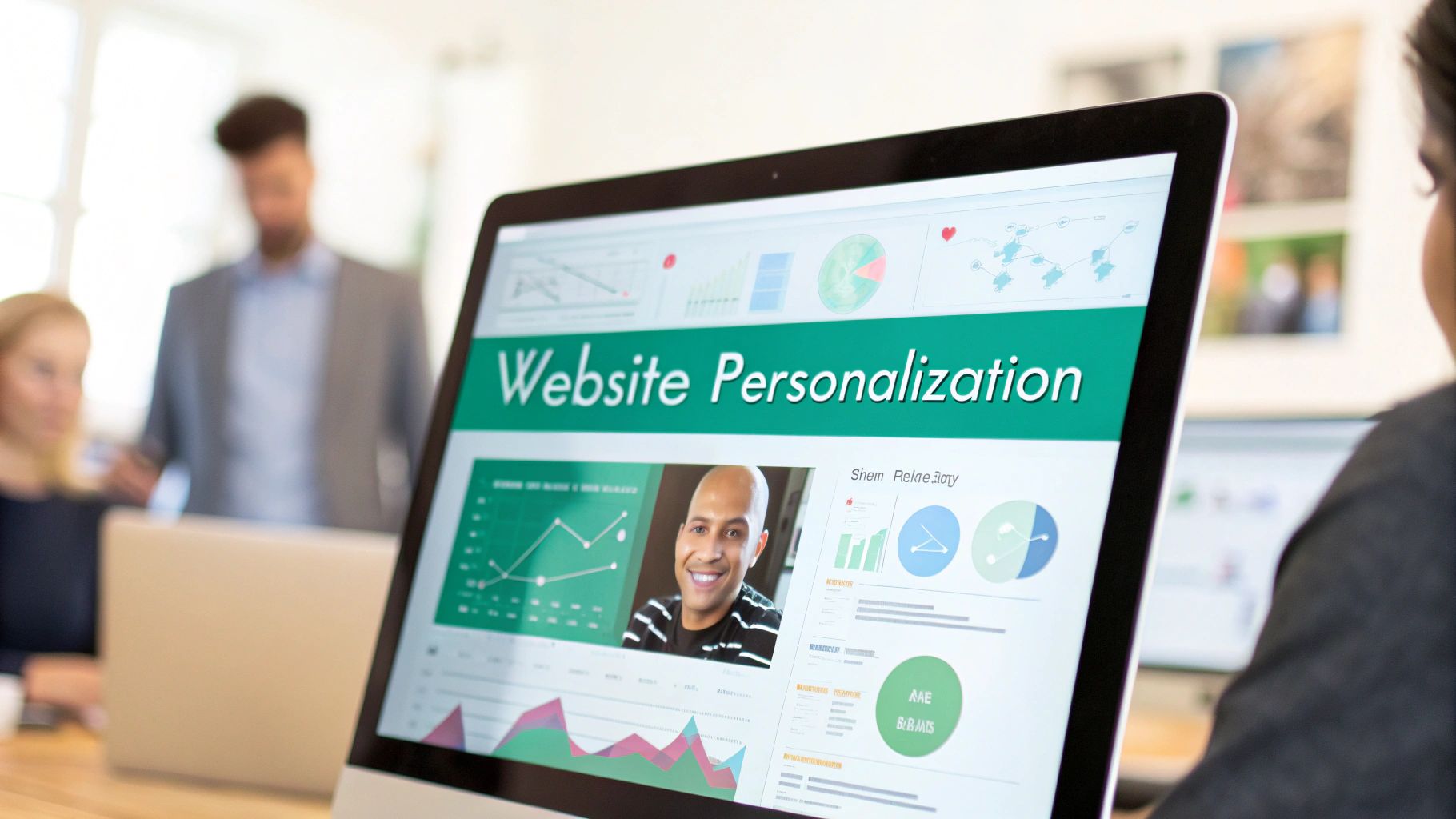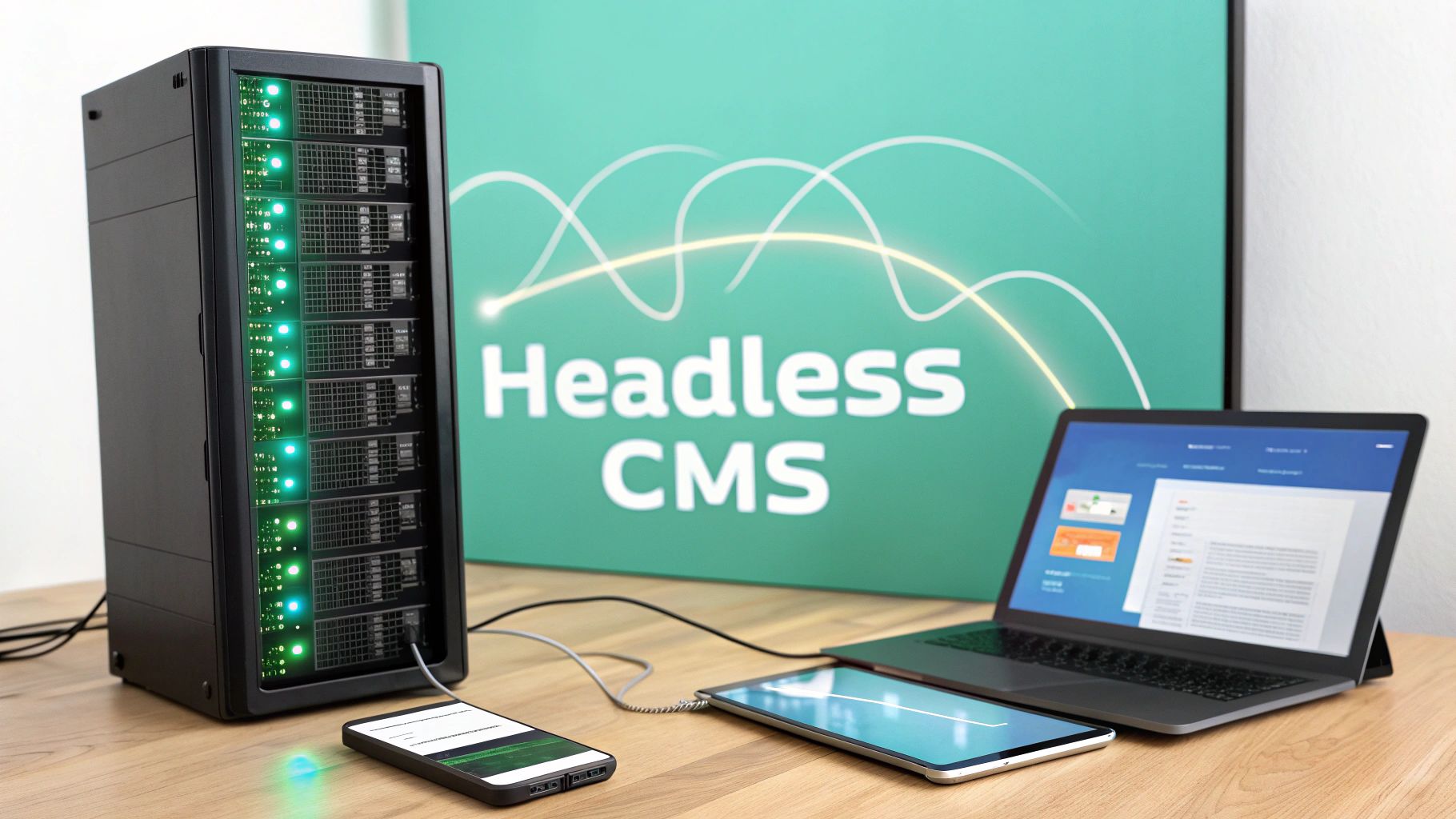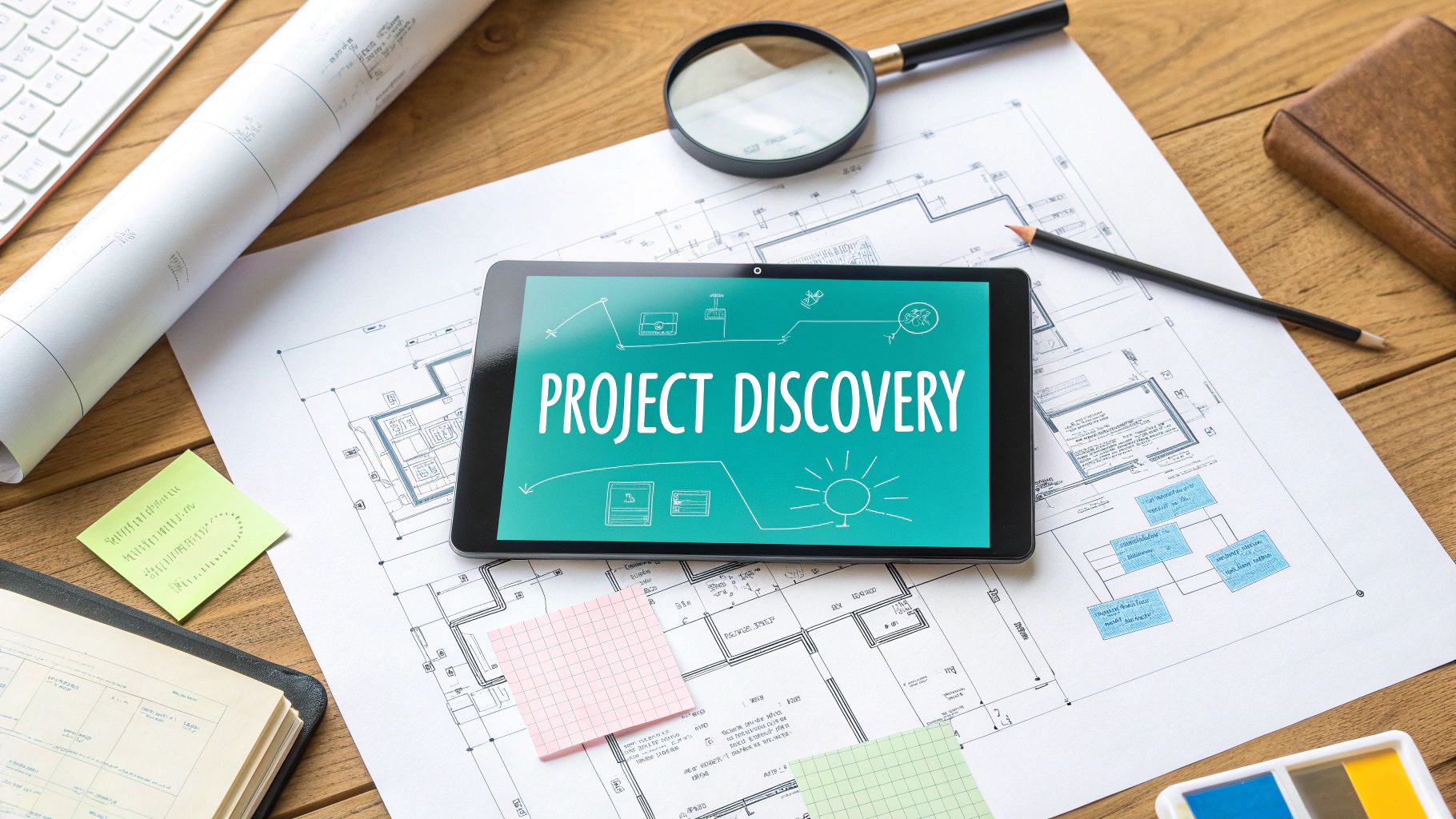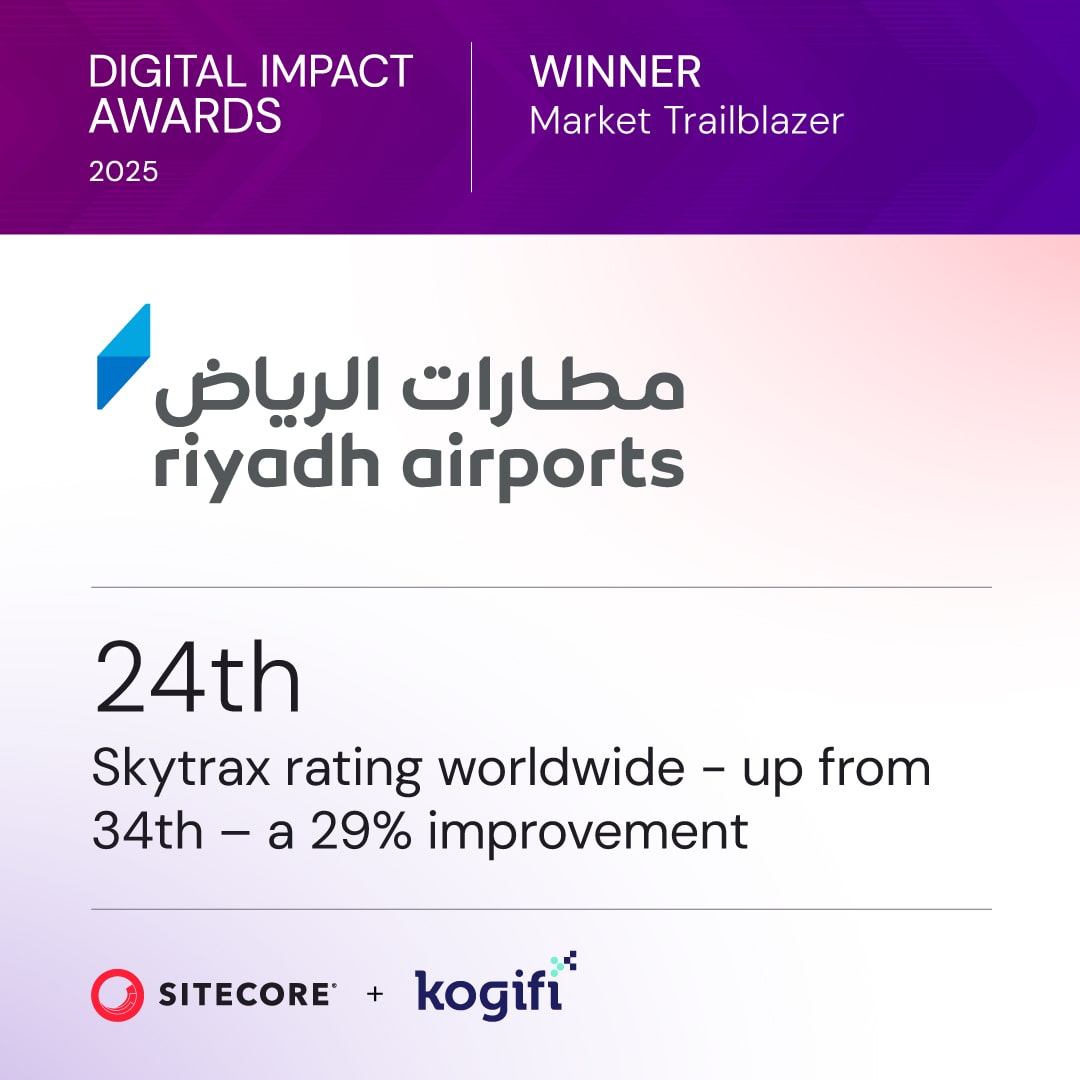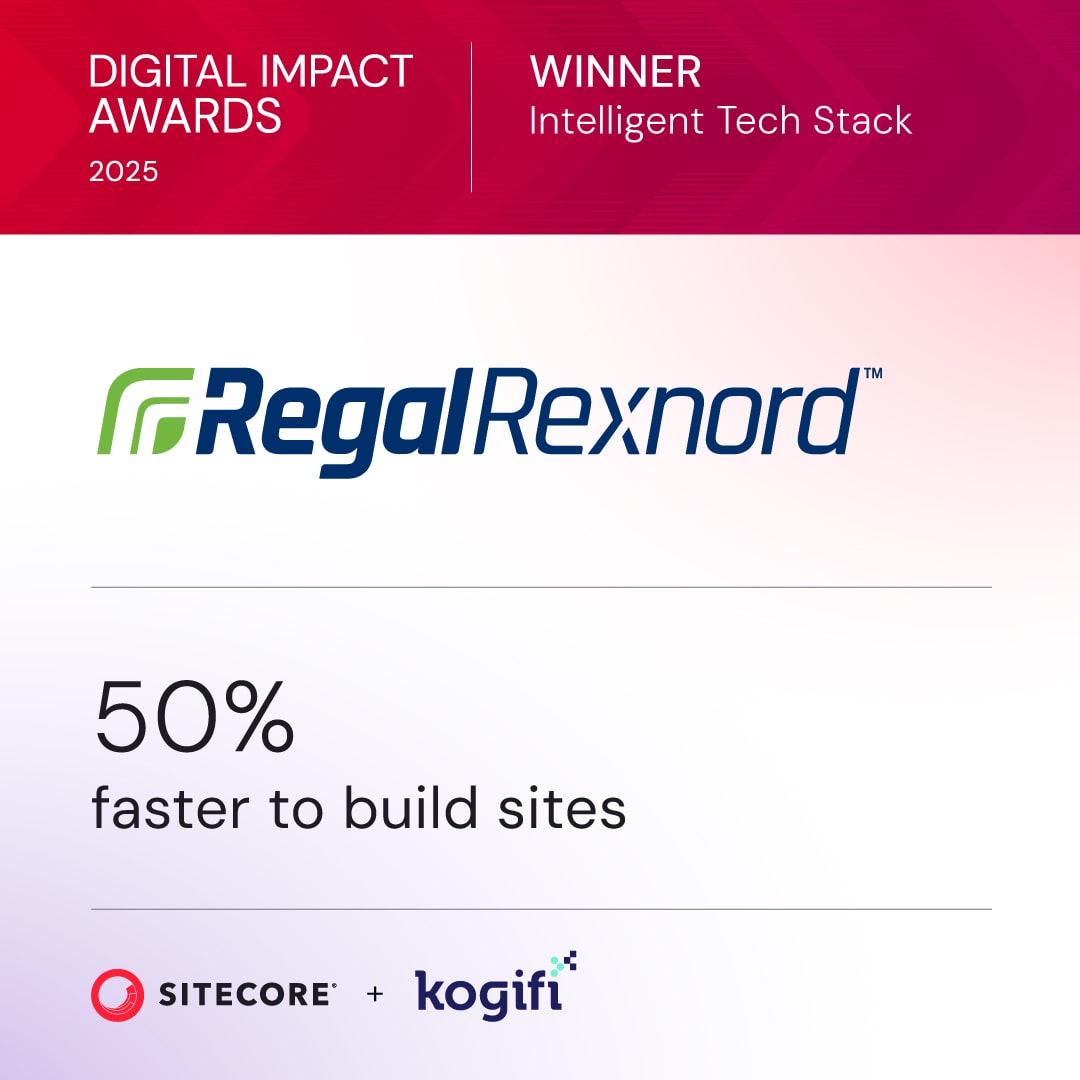Website personalization is all about creating custom-tailored experiences for every person who visits your site. Instead of throwing the same static page at everyone, personalization dynamically adjusts content, offers, and interactions based on who the user is. It turns a generic monologue into a personal, one-to-one conversation.
The End of One-Size-Fits-All Websites
Imagine walking into a store where the staff already knows your style and preferences. That’s the feeling website personalization aims to create. It’s a massive shift away from the old era of impersonal, one-size-fits-all digital storefronts.
A static website is like a generic catalog left on a doorstep—it offers the same thing to everyone, no matter their interests or what they need. A personalized website, on the other hand, acts like a skilled personal shopper. It observes your behavior, understands your context, and guides you to exactly what you’re looking for, sometimes before you even realize you need it.
Why Static Websites No longer Work
Today’s users have come to expect digital experiences that recognize them as individuals. A generic website just creates friction and leads to missed opportunities, whereas a tailored approach builds an immediate connection.
This shift is driven by a simple truth: relevance drives results. When content speaks directly to a visitor's needs, it grabs their attention and encourages them to take the next step. This is where powerful Digital Experience Platforms like Sitecore excel, providing the sophisticated tools needed to transform a standard website into an intelligent, adaptive experience that drives business outcomes.
By tailoring experiences, businesses create meaningful connections that build lasting loyalty and drive significant revenue. The goal is to make every visitor feel like the website was designed specifically for them.
The Power of Contextual Experiences
Great website personalization is about more than just using a visitor's name. It digs deeper into understanding their context, all powered by solid data collection and analysis. A platform like Sitecore Experience Platform (XP) builds a comprehensive profile for each user, tracking their interactions over time to make every future visit even smarter.
This data opens the door to some pretty sophisticated strategies, such as:
- Behavioral Targeting: Showing content based on pages viewed, resources downloaded, or past purchases.
- Real-Time Adaptations: Changing up hero banners or calls-to-action the moment a user’s behavior signals a specific interest.
- Segment-Based Content: Delivering different messages to first-time visitors versus loyal, returning customers.
Ultimately, moving away from static websites is a move toward putting the customer at the center of everything. As you dig into more advanced strategies, our guide on a simplified approach to personalization on the web can offer some extra insight. With the right tech and a smart strategy, you can make sure your digital presence isn’t just seen, but truly felt.
Why Personalization Is a Revenue Multiplier
Investing in website personalization isn't just a "nice-to-have" for improving the user experience; it's a hard-hitting strategy for growing your bottom line. When you start shaping digital journeys around individual users, you stop being a passive product showcase and start actively guiding visitors toward a purchase. This shift turns a static website into your best salesperson.
The link between a well-executed personalized experience and your business metrics is direct and undeniable. By showing people the right content at the right time, you naturally boost conversion rates. You’re no longer making them hunt for what they need—you’re bringing it right to them, cutting out friction and shortening their path to checkout.
This kind of smart guidance also pushes up the average order value. Think of it like a sharp retail associate who knows exactly which accessory will complete an outfit. In the same way, a personalized website powered by a platform like Sitecore uses data to make intelligent, contextual recommendations, encouraging shoppers to add just one more perfect item to their cart.
From One-Time Sales to Lifelong Loyalty
Beyond the immediate sale, personalization is the bedrock of building real, long-term customer relationships. When a visitor feels like you get them, they're far more likely to come back. That repeat engagement is what builds genuine brand loyalty, the engine of sustainable growth.
Every positive and relevant interaction stacks on top of the last, steadily increasing a customer's lifetime value. A platform like Sitecore is built for this, creating a unified Experience Profile for every user. This profile logs each interaction, allowing you to deliver personalization that gets sharper and more meaningful over time. If you fail to meet this expectation, you’re not just missing an opportunity—you’re actively pushing customers away.
The image below perfectly captures the difference between a generic, one-size-fits-all website and a dynamic, personalized one.
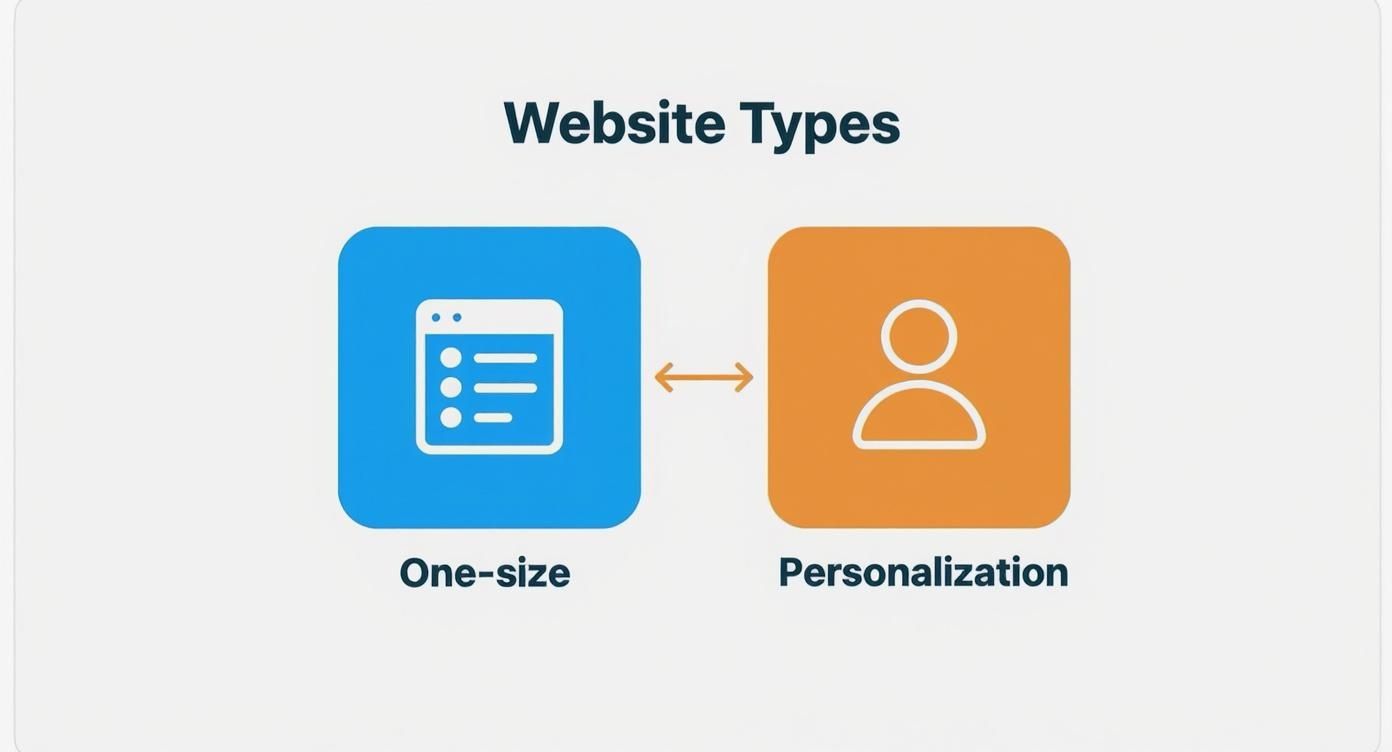
As you can see, personalization ditches the old-school catalog model for an experience that's built entirely around the individual, their profile, and what they need in the moment.
The Undeniable Financial Impact
The effect of personalization on revenue is no longer just a theory; it's a proven fact. Today’s consumers don’t just prefer personalized interactions—they expect them. And the businesses that deliver are the ones seeing massive returns.
Personalization isn't just a feature; it's your most powerful competitive advantage. It directly impacts your most important KPIs by making every digital touchpoint smarter and more effective.
The numbers don't lie. Take a look at what recent industry reports have uncovered about the real-world impact of getting personalization right.
Impact of Personalization on Key Business Metrics
This table showcases the direct business benefits and ROI achieved through effective website personalization strategies, highlighting key statistics.
These figures tell a clear story: personalized digital experiences are a core driver of modern business growth. If you want to dive deeper, you can explore more data on the impact of personalization in eCommerce to see the full picture.
Ultimately, personalization is a powerful revenue multiplier. It turns browsers into buyers, buyers into repeat customers, and customers into loyal advocates for your brand. By investing in technologies that enable deep, meaningful personalization, like the Sitecore product suite, you are making a direct investment in a more profitable and sustainable future for your business.
Building Your Personalization Strategy
Putting the idea of website personalization into practice isn’t just about flipping a switch; it requires a clear strategy. Think of it as creating a playbook for your digital experiences. Instead of one rigid game plan, you'll develop multiple approaches that adapt to different visitors and their unique journeys. A solid strategy is the foundation upon which powerful platforms like Sitecore and SharePoint build those truly engaging, relevant interactions.
The first step is to stop seeing your audience as one big, monolithic group. You need to start identifying and grouping them into meaningful categories. This foundational approach, known as segmentation, allows you to deliver content based on shared characteristics. For example, a B2B company might show a completely different homepage to a visitor from the healthcare industry versus one from financial services.
This is where the power of a mature Digital Experience Platform (DXP) like Sitecore really shines. Sitecore doesn't just guess who your visitors are; it builds a detailed profile based on explicit data (like what they tell you in a form) and implicit data (like the pages they visit). This allows for pinpoint segmentation that goes way beyond basic demographics.
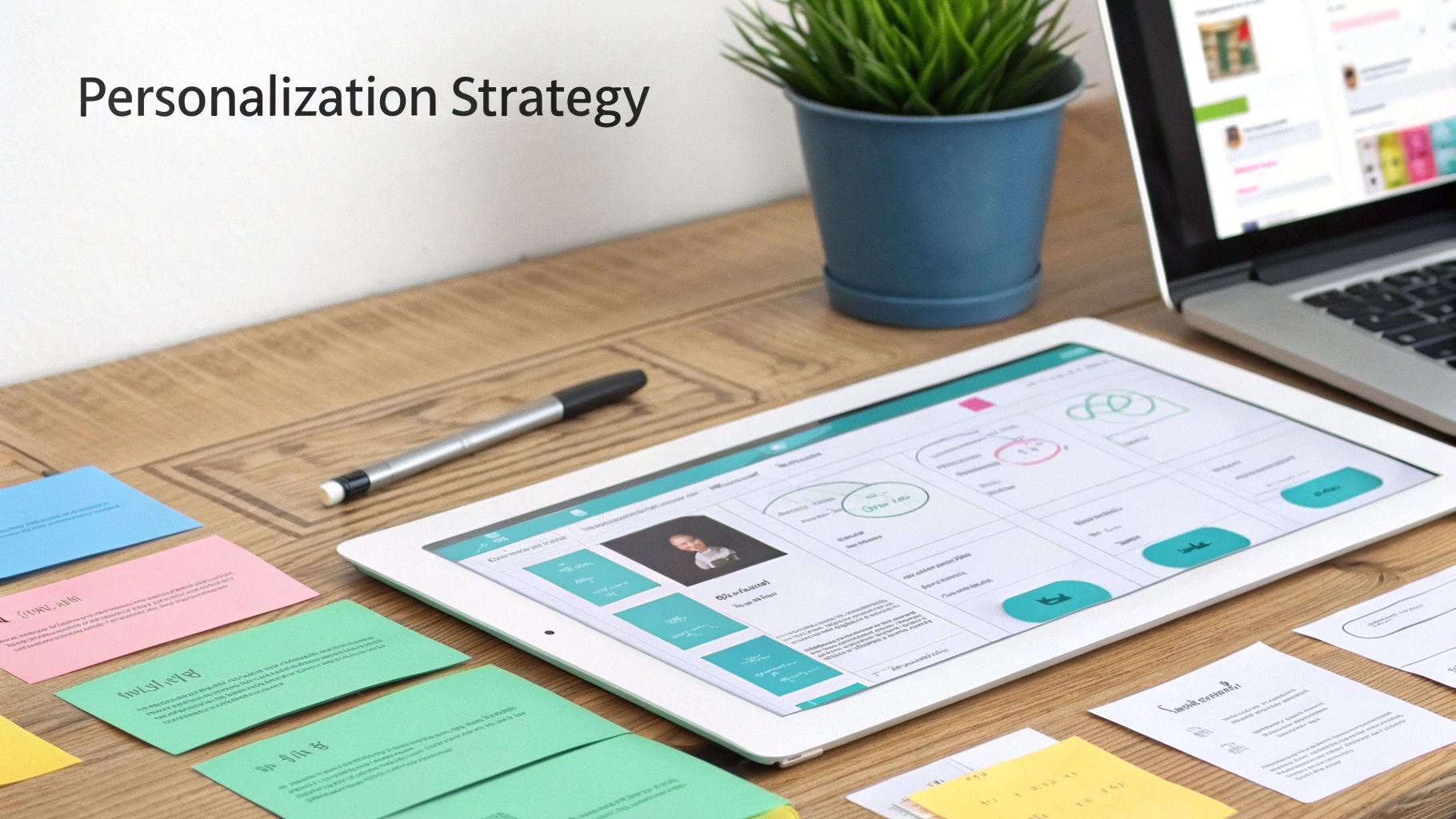
Foundational Personalization Tactics
To start building out your playbook, it's best to focus on two core tactics that deliver immediate, tangible value. Think of these as the building blocks for more advanced, real-time strategies down the road.
- Geographic Targeting: This is exactly what it sounds like—customizing content based on a visitor's location. A retailer could display a promotion for winter coats to users in colder climates while showing swimwear to those in tropical regions. In a platform like Sitecore, this is a simple rule to implement and offers a quick, satisfying win.
- New vs. Returning Visitors: The needs of a first-time visitor are worlds apart from those of a loyal customer. You can personalize the experience by showing a "Welcome" offer or an introductory video to new users, while presenting returning customers with "What's New" content or loyalty rewards.
These initial steps are perfect for demonstrating the value of website personalization without overwhelming your team. As you start defining your strategy, it’s a good idea to explore the various website personalization tools available to see what fits your needs.
Advancing with Behavioral and Real-Time Targeting
Once you’ve got a handle on segmentation, the next level is behavioral targeting. This strategy adapts the user experience based on the actual actions a visitor takes during their session or across multiple visits. If someone downloads a whitepaper on a specific product, you can follow up by showing them related case studies or testimonials the next time they stop by. Sitecore’s powerful rules engine excels here, allowing marketers to set up these "if-then" scenarios without having to call a developer.
The ultimate goal, of course, is real-time personalization, which reacts instantly to what a visitor is doing right now. Imagine a visitor browsing multiple articles about a particular service. A real-time system can dynamically change the homepage hero banner to feature that exact service on their very next page load. It's powerful stuff.
Consumer expectations have absolutely soared, and generic, one-size-fits-all experiences just don't cut it anymore. Research shows that 74% of consumers get frustrated when websites fail to deliver personalized content—a clear signal that brands must start recognizing customers as individuals.
This growing demand for individualized interactions is completely reshaping digital engagement. In fact, 71% of consumers now flat-out expect companies to provide personalized experiences, which shows a fundamental shift in user behavior. Platforms like Sitecore Personalize are built specifically to meet this demand, using AI to deliver these one-to-one moments at scale.
Executing Advanced Personalization with Sitecore
While foundational strategies like segmentation get you in the game, executing truly advanced personalization of website experiences requires a powerful engine. This is where the Sitecore ecosystem comes in, moving way beyond basic targeting to create genuine one-to-one digital conversations at a massive scale. It’s a complete, integrated toolkit for orchestrating complex and highly effective customer journeys.
At the heart of it all is the Sitecore Experience Platform (XP). Think of Sitecore XP not just as a Content Management System (CMS), but as a central brain. It collects, connects, and acts on customer data from every single touchpoint. Every interaction—a page view, a download, a form submission—is captured and used to build an incredibly detailed visitor profile.
This rich data hub is known as the Sitecore Experience Profile (xProfile). It’s a living, breathing, 360-degree view of each customer that goes far beyond simple demographics. It tracks behavioral patterns, goal completions, and engagement value over time, creating the fuel that powers every sophisticated personalization tactic on the platform.
Powering Real-Time Decisions with Sitecore Personalize
To act on all this data in the moment, Sitecore offers Sitecore Personalize. As a key part of its composable DXP portfolio, this is a cloud-native solution designed for pure speed and intelligence. It uses AI and machine learning to analyze user behavior as it happens, allowing for instant adaptations to the digital experience.
For instance, if a visitor suddenly starts browsing a specific product category, Sitecore Personalize can trigger immediate changes on the site:
- Dynamic Content: The hero banner on the homepage can instantly swap to feature that product category.
- Contextual Offers: A targeted promotion related to their browsing behavior might pop up.
- Triggered Experiences: An automated chat prompt can offer help from a specialist in that product area.
This is the kind of real-time responsiveness that separates basic personalization from an experience that feels truly intuitive. You can learn more in our guide on the 5 simple steps toward better personalization with Sitecore Personalize.
Building Complex Scenarios with the Rules Engine
One of Sitecore's most empowering features is its user-friendly Rules Engine. This tool allows marketing teams to build complex personalization scenarios without writing a single line of code. It uses a simple "if-this-then-that" logic, making sophisticated targeting accessible to everyone.
The screenshot from Sitecore's website below shows how the platform focuses on creating seamless, end-to-end customer journeys.
This visual highlights how Sitecore's tools are built to manage every stage of the customer lifecycle—from initial acquisition to long-term loyalty—all driven by data.
Using the Rules Engine, a marketer could easily set a rule like this:
"IF a visitor is from the financial industry, has visited the 'Enterprise Solutions' page more than twice, AND is a returning visitor, THEN show them the 'Financial Services Case Study' component on the homepage."
This granular control lets you create hyper-relevant experiences that speak directly to a user's specific context and intent. It transforms the website from a static brochure into a dynamic, intelligent tool that adapts to each visitor's needs.
An Integrated Ecosystem for Measurable Results
The real strength of Sitecore is that it's all connected. Sitecore XP, Sitecore Personalize, and the rest of the composable suite—like Sitecore CDP and OrderCloud—work together seamlessly. This creates a unified data layer that ensures every part of the digital experience is consistent, connected, and intelligent.
This integration delivers results you can actually measure. By tying personalization efforts directly to analytics and business goals, you can see exactly how tailored experiences are impacting your KPIs. You can track conversion lifts, increased engagement, and higher customer lifetime value, proving a clear return on your investment. With Sitecore, advanced personalization isn't just a feature; it's a core business strategy that drives tangible growth.
Driving Engagement with SharePoint Solutions
While Sitecore is the master of personalizing external customer journeys, the core principles of delivering relevant content are equally vital for internal audiences. This is where a different set of tools comes into play, designed not for driving sales, but for boosting employee productivity and streamlining partner collaboration. This is the domain of Microsoft SharePoint.
SharePoint excels at creating tailored digital workspaces. Instead of tracking granular behavioral data like a DXP, SharePoint leverages the rich, structured identity data already present within an organization. By tapping into Azure Active Directory (AAD), it uses attributes like a user's department, role, location, and team memberships to deliver a clean, relevant, and secure experience without the need for complex behavioral profiling.
Audience Targeting for Internal Efficiency
The core personalization feature in SharePoint is audience targeting. This powerful yet straightforward tool acts as a smart filter for intranets and partner portals. It allows administrators to define which groups of users see specific content, ensuring that employees are presented with information directly relevant to their work, eliminating digital clutter.
This approach is highly effective for improving the internal user experience. For example, audience targeting can be applied to:
- News and Announcements: The marketing team sees the latest campaign updates front and center, while the IT department gets alerts about upcoming system maintenance. No more inbox clutter.
- Document Libraries: A sales team in North America gets instant access to their regional price lists, while the European team sees theirs. This simple trick prevents mix-ups and saves everyone time.
- Navigation Links: You can show links to specific project sites or departmental resources only to the team members who need them. This creates a much cleaner, more intuitive navigation menu for every single person.
By tying content visibility directly to a user's role and team in AAD, SharePoint transforms a chaotic, one-size-fits-all intranet into a focused, role-specific dashboard. This directly boosts engagement by making it dead simple for people to find what they need to do their jobs.
A Tale of Two Platforms
This highlights a key difference in personalization strategy: the right tool always depends on your audience and your goal. Sitecore is built for the wild, unpredictable world of the external customer journey, using AI and deep behavioral data to drive revenue. SharePoint, on the other hand, is purpose-built for internal and partner efficiency.
At Kogifi, our expertise spans both worlds. We architect solutions based on the business need, knowing when to deploy SharePoint for internal productivity and when to bring in Sitecore's DXP for customer growth. You can see how we tailor these platforms in our detailed overview of SharePoint solutions and their role in creating modern digital workplaces.
Ultimately, the goal is always the same: get the right content to the right person at the right time. Whether that person is a potential customer or a valued employee, a personalized experience is the key.
The Future Is Hyper-Personalized with AI
Simple segmentation is old news. The next wave of digital experience is all about hyper-personalization—crafting a unique, one-to-one journey for every single person who lands on your site. This isn't just about showing a different banner; it's about using the predictive muscle of Artificial Intelligence (AI) and machine learning to build an experience on the fly.
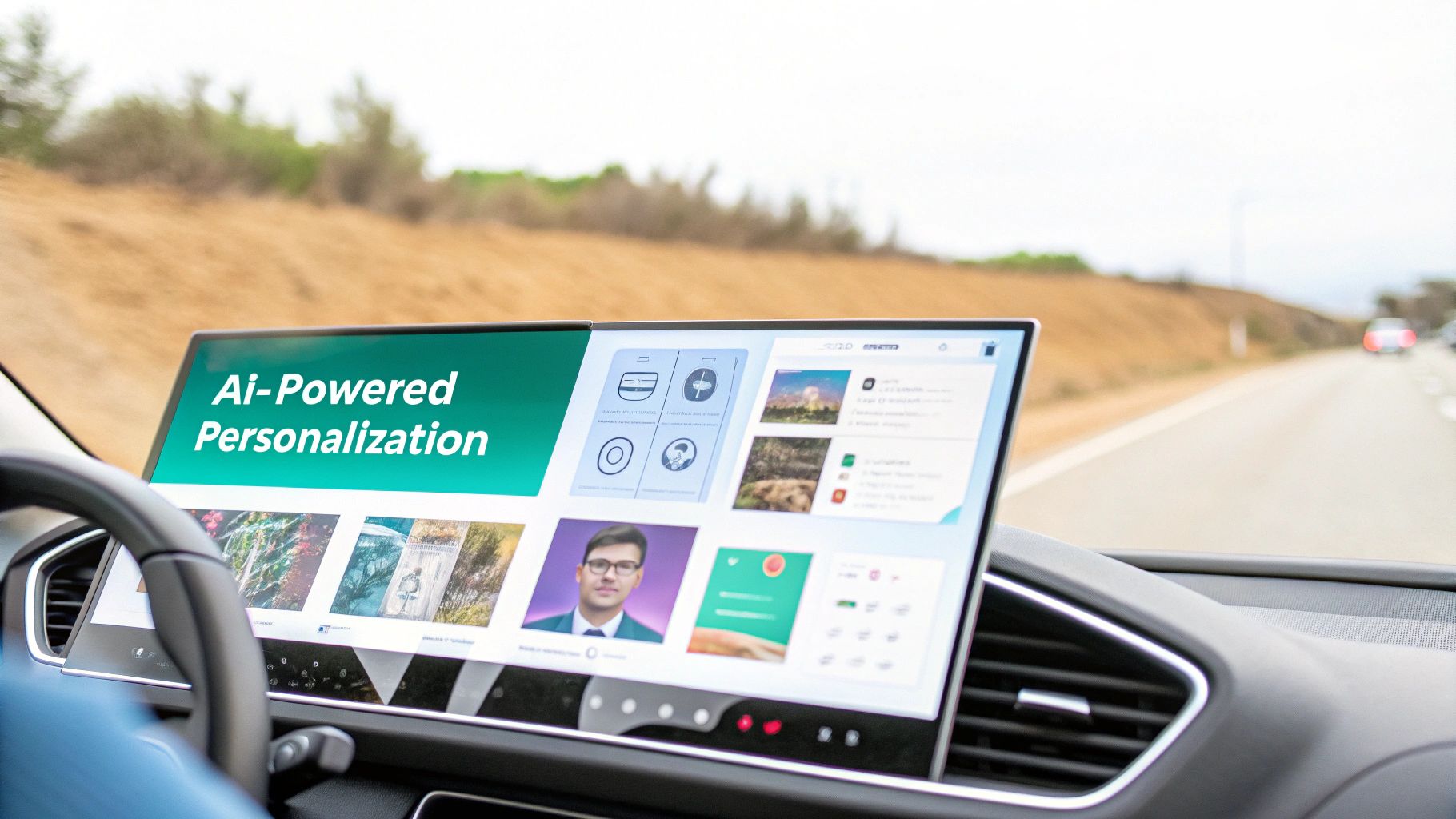
AI algorithms dig through enormous datasets to figure out what a user wants, often before they even know themselves. They can suggest content with eerie accuracy and even reshape a website's layout in real time to match a visitor's immediate needs. The result is a fluid, intuitive experience that feels less like a website and more like a personal concierge.
Sitecore and the AI-Powered Future
This is precisely the future the Sitecore product suite is built for. With its deep commitment to AI, Sitecore gives businesses the power to automate and fine-tune their personalization efforts on a scale that would be impossible for humans to manage. It uses AI to comb through user data, spot hidden patterns, and deliver the perfect experience at the perfect moment.
The shift is already happening. Today, 92% of businesses are already using AI-driven personalization tactics. It’s clear the industry is paying attention, as a massive 73% of business leaders agree that AI will fundamentally change how they approach personalization.
Staying Ahead with the Right Partner
But having a future-proof platform is only half the battle, especially as customer expectations keep climbing. You also need an expert partner who knows how to connect that powerful technology to your actual business goals. AI isn't just a shiny feature; it’s a strategic layer that has to be woven into your entire digital game plan.
Hyper-personalization powered by AI is the new standard for customer engagement. It moves beyond reacting to user behavior and starts proactively anticipating their needs, creating a truly seamless and valuable digital journey.
To see how AI, and specifically Natural Language Processing, is enabling more intuitive user experiences, check out this piece on how NLP powers personalization in BI tools. This level of intelligence is what it takes to stay ahead. You can learn more about putting this technology to work in our guide to artificial intelligence in personalization.
Frequently Asked Questions
Jumping into personalization can feel like a huge undertaking. You know the concepts, but how do you actually get started? Below, we tackle some of the most common questions that pop up when you're ready to move from theory to practice.
What Is the First Step to Start Personalization?
Don't try to boil the ocean. The biggest mistake people make is trying to personalize everything all at once. The best starting point is to focus on your most valuable visitor segments and what they want to achieve.
Start small by defining just one or two key audiences. A classic example is ‘new visitors’ versus ‘returning customers.’ Then, map out a simple personalization rule for each. You could greet new visitors with a welcome offer or show your loyal customers the latest content you’ve published. This focused approach lets you test, learn, and prove the value of personalization before you even think about scaling up.
How Do Sitecore and SharePoint Differ?
This is a great question because it gets to the heart of using the right tool for the job. While both Sitecore and SharePoint offer personalization, they’re built for completely different worlds. Think of it as a specialized tool for external marketing versus one for internal efficiency.
- Sitecore is a full-blown Digital Experience Platform (DXP) designed for sophisticated, one-to-one marketing. It dives deep into behavioral data and uses AI to map out complex customer journeys that drive sales.
- SharePoint is all about internal and partner collaboration. Its personalization is mostly rule-based, targeting audiences based on their Azure Active Directory profiles—like showing specific resources to someone in the Sales department versus the Engineering team.
In a nutshell, Sitecore is your go-to for personalizing the external customer journey to grow your business. SharePoint is built to streamline internal communication and make your teams more efficient.
How Do You Measure the ROI of a Personalization Project?
Proving the value of personalization comes down to one thing: data. To measure your return on investment, you need to track key metrics against a control group—that is, users who see the generic, non-personalized version of your site. The gold standard for this is A/B testing.
Set up your tests to monitor metrics that matter to your bottom line:
- Did conversion rates for specific goals go up?
- Did the average order value (AOV) increase?
- Are people more engaged? Look at metrics like pages per session or time on site.
By comparing the performance of the personalized experience against the default, you can directly attribute any lift in revenue or engagement to your efforts. It’s the clearest way to show everyone, from your team to the C-suite, that personalization is working.
Ready to transform your digital presence with powerful, data-driven personalization? Kogifi has the expertise to architect the perfect solution for your business, whether you need to engage customers with Sitecore or empower employees with SharePoint. Get in touch with us today to start building smarter, more effective digital experiences.

















